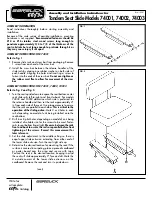
CentriMag Blood Pump IFU (RVAS HDE)
Page 3 of 8
© 2015 Thoratec Switzerland GmbH – Document No. PL-0085, Rev. 09 (May 2015)
LVAD. Fourteen patients received biventricular
CentriMag devices. Average duration of support for
these 24 patients was 14.3 days (range: 1 – 60 days).
Twelve patients (50%) were alive at 30 days. In
general, the survival outcome for males and females
appeared comparable, though it is difficult to draw
conclusions regarding sex-specific outcomes due to
the limited clinical experience with the CentriMag
RVAS.
Pump flow remained stable at ranges of approximately
4.5 – 6.0 LPM. In general, central venous pressure
decreased over time while on support while mean
arterial pressure remained stable. Indicators of end-
organ function demonstrated stable renal and hepatic
function in survivors. Non-survivors demonstrated
signs of deteriorating end-organ function over time as
evidenced by worsening renal and hepatic laboratory
measurements (increasing BUN and total bilirubin
levels, respectively), although some laboratory
indicators of renal function (creatinine levels) remained
stable over time. Previous studies of short-term
ventricular assist devices have shown increases in
BUN with stable creatinine, citing cardiogenic shock as
a possible precursor to mild renal dysfunction.
The studies were not powered for a specific analysis of
adverse event rates. All adverse events were reported
by the clinical centers, regardless of the relationship to
the device. Investigators were required to classify the
cause of each event as being device-related, patient-
related, management-related or other-related. There
were no new types of adverse events observed. Rates
of adverse events were within the expected range for
patients with RV failure supported by a mechanical
circulatory support device. As expected in this patient
population, the rate of bleeding (84%), infection (53%)
and respiratory failure (66%) was high, although the
number of these events which were directly attributable
to the device was relatively low. In many instances, the
patients’ chests were not closed after the initial
surgery, requiring a planned reoperation. In the case of
infection, all infections diagnosed during the period of
VAD support were classified as “device related”, unless
the infection had been diagnosed and the organism(s)
cultured prior to initiation of VAD support. There were
no instances of device failure.
In a review of adverse events by gender, there was a
potential trend toward higher rates of bleeding and limb
ischemia in males, and a potential trend toward higher
rates of infection, arrhythmias, and neurologic
dysfunction in females. None of these potential trends
were statistically significant. The small sample size
and variability of patient population (as evidenced in
baseline characteristics) makes it difficult to draw any
conclusions. Risks associated with the CentriMag
RVAS are consistent with those associated with
commercially approved devices and alternative
treatment options.
The positive outcome data combined with the low
incidence of device related adverse events suggest the
benefits associated with use of the CentriMag RVAS
VAD outweigh the risks.
This risk-benefit ratio is
highlighted when taking into account the risks and
benefits associated from alternative methods of
treatment, and from the morbidity and mortality
associated with cardiogenic shock if left untreated.
RECOMMENDED ANTICOAGULATION GUIDELINES
It is intended that systemic anticoagulation be utilized
while the CentriMag System is in use. Anticoagulation
levels should be determined by the physician based on
risks and benefits to the patient. In general, the
following anticoagulation guidelines should be
considered.
•
For patients that were on cardiopulmonary bypass:
o
No anticoagulation for 6-12 hours after device
placement
o
Start heparin infusion if chest tube output is <
50 cc/hr for 2-3 hrs
o
Target ACT 160-180 sec (e.g. Hemochron
Celite ACT)
o
Target PTT 1.3-1.6 (e.g. 39-48) times
laboratory normal for patient
o
Add platelet anti-aggregant (e.g. 81-325 mg
aspirin per day) by the 4
th
post-op day
o
Target ACT 250-300 sec for weaning or for
persistent low flow conditions
•
For patients that did not undergo cardiopulmonary
bypass:
o
Start heparin infusion if chest tube output is <
50 cc/hr for 2-3 hrs
o
Target ACT 160-180 sec (e.g. Hemochron
Celite ACT)
o
Target PTT 1.3-1.6 (e.g. 39-48) times
laboratory normal for patient
o
Add platelet anti-aggregant (e.g. 81-325 mg
aspirin per day) by the 4
th
post-op day
o
Target ACT 250-300 sec for weaning or for
persistent low flow conditions
INDICATIONS FOR USE
The CentriMag RVAS is intended to provide temporary
circulatory support for up to 30 days for patients in
cardiogenic shock due to acute right ventricular failure.
CONTRAINDICATIONS
This CentriMag RVAS is contraindicated for use as a
cardiotomy suction device. It is also contraindicated for
patients who are unable or unwilling to be treated with
heparin or an appropriate alternative anticoagulation.
INSPECTION PRIOR TO USE
1. The packages containing the blood pump,
cannulae, tubing and connectors should be
inspected prior to use for any damage to the sterile


























